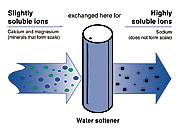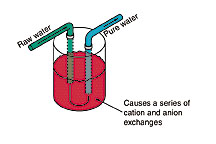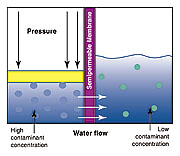Humidification is the process of transforming water into vapor, and so it is not surprising that water type has a great impact on humidifier performance, maintenance requirements, humidification vapor quality, and efficiency of operation.

Types Of Water And Their Risks
There are four types of water used in humidifiers:
- Potable water (drinking, tap, or well water);
- Softened water (hardness reduced through an ion exchange process);
- High-purity water (deionized and/or reverse osmosis treated [DI/RO] water); and
- Boiler water (typically treated with anticorrosion chemicals).
Potable water is usually safe for drinking but can be hard on humidifiers. Potable water, commonly referred to as drinking, tap, or well water, can contain any number of living microorganisms, dissolved organic material, dissolved minerals, and suspended materials. While all of these substances can influence humidification vapor quality, humidifier maintenance, performance, and efficiency are significantly affected by dissolved minerals and suspended materials.
Living microorganisms (bacteria) are killed when water is heated to 180°F, and so bacteria are not a concern when using isothermal humidifiers, which boil water to make steam (vapor). However, care should be taken to ensure that all harmful microorganisms are removed from water sources feeding nonboiling (adiabatic) humidifiers such as air washers, foggers, atomizers, or pezio disk systems.
In addition, even though a water supply may be free of harmful bacteria, contaminants from the air can still cause microbial growth in wetted-media or wick systems. Water treatment for bacteria includes filtration, reverse osmosis, chemical oxidation, disinfection, and deionization. The most common treatment for bacteria is chemical oxidation by either ozonation or by adding chlorine. Dissolved organic material comes from three major sources:
- The breakdown of naturally occurring organic materials (plant and animal matter);
- Domestic and commercial chemical wastes (agricultural and urban runoff, or leaching from contaminated soils); and
- Chemical reactions that occur during water treatment processes (from disinfection by-products or pipe joint adhesives).
Activated carbon and microfiltration, as well as reverse osmosis and deionization processes, remove dissolved organic material.
Dissolved minerals found in potable water are magnesium, calcium, iron, and silicon, with calcium and magnesium as the primary elements causing "hard" water. Water hardness is commonly measured in grains per gallon (gpg). As water hardness increases, so does the need for humidifier cleaning to remove scale buildup. Downtime for cleaning, as well as time required to heat fresh water that replaces frequently skimmed or drained water (to remove minerals), can significantly affect humidifier performance and efficiency. Filtration removes some dissolved minerals, while water softening is the most common method for reducing water hardness.
Suspended materials, such as clay or silt, give water a cloudy appearance. These particles should be removed from humidifier makeup water, as they will settle out and collect in humidifier water reservoirs. These particles are typically removed by filtration.

Advantages Of Softened Water
Water softening is an ion exchange process where slightly soluble magnesium and calcium ions are replaced by very soluble sodium ions. The exchanged sodium ions stay in solution when in water and do not attach to humidifier tank walls and elements as scale, like magnesium and calcium, will.Softening water can dramatically improve humidifier performance, maintenance requirements, and efficiency. It is not unusual for systems using softened water to go several seasons without cleaning. However, water softeners need their brine tanks regularly replenished with sodium (so that there are sodium ions available to exchange with the magnesium and calcium ions) and, for this reason, owners should regularly inspect their humidifiers using softened water to verify softener operation. To lessen maintenance requirements, we recommend softening water for humidifier use where water hardness is greater than 12 gpg.
The process of softening water can increase water conductivity, and so some electric isothermal systems (such as plastic cylinder systems that heat water with electrodes) will not operate efficiently using softened water. Electrode systems heat by sending an electric current through water and, therefore, require water to be within a specific range of conductivity to operate. To reduce conductivity levels and to remove minerals if there is no automatic skimmer, electrode systems may need to be flushed frequently. This frequent flushing will reduce performance and increase energy usage.
When purchasing a humidifier system, be sure to ask how softened water affects not only maintenance (softened water should reduce maintenance requirements), but efficiency and performance, as well. Electric systems using element heaters (not electrodes) will work in any type of water (tap, softened, or DI/RO), for they do not rely on water conductivity to operate.

High-Purity Water And Critical Process Environments
Semiconductor, pharmaceutical, and electronics manufacturers, as well as laboratories, industrial cleanrooms, and healthcare facilities often require high-purity humidification. To avoid water con-taminants that can be carried into the air with water vapor, these types of environments use highly processed - and very pure - water in their humidification systems.For these environments, water is cycled through several prefilters, through a reverse-osmosis permeable membrane and, frequently, through a chemical deionization process. This type of high-purity water is often called DI/RO water and, depending on the quality of process, can be free of minerals and other contaminants. The purity of this water will degrade upon contact with the atmosphere and certain materials and should remain in a closed system contacting only chemically stable materials.

Properly Maintained DI/RO Water Is Not Corrosive
If a DI/RO system is functioning properly and well maintained, the water produced consists solely of hydrogen and hydroxides and is free of most or all total dissolved solids (TDS) including chlorides and other molecules that cause metal corrosion.Many users of high purity water have the false impression that it is highly corrosive to metals. This may be due, in part, to the water quality found in systems that have not been properly maintained or operated. If, for example, DI beds are not properly maintained, or the flow rate through them exceeds their capacity, the first of the two DI beds (the anion bed) will typically become saturated or ineffective, and then the weak acid solutions generated by the second bed (the cation bed) cannot be neutralized and flow into the water system. If this happens, chlorides and other electrolytes are introduced into the system in large quantities, with the ability to cause substantial corrosion. Another misconception about DI/RO water is that its ion-hungry nature causes metal corrosion, but while properly maintained high-purity water will take some ions from the metal it contacts, this exchange process causes, at worst, only minimal corrosion.

How Water Type Affects Humidifier Performance
Isothermal systems - systems that boil water to make steam (vapor) - typically maintain relative humidity (rh) levels within 1% to 5% of an established setpoint, with the ability to maintain a specific level of control directly dependent on the system's ability to respond to changing environmental conditions. Responsiveness is affected by two things: delivery of the energy source, and the amount of water discarded (through skim, drain, and flush cycles) to remove minerals.Key to delivering a responsive energy source is a control system that quickly adapts to changing and often unique environmental conditions. But given the same controller, a system with a modulating valve, such as a boiler-steam heat exchanger system, will have a bit of an edge over electric and gas isothermal systems because of the infinite variability of a modulating steam valve - it truly provides energy to heat water on demand. Gas and electric systems however, come very close to achieving this capability, making the comparison mostly academic.
Water hardness, however, plays a critical part in an isothermal humidifier's ability to maintain rh setpoint. As water hardness increases, so does the need for skimming, draining, and flushing. Skimming removes precipitated minerals before they attach to humidifier tank walls and elements as scale. As water is skimmed off, cold water is introduced into the tank. In some cases, this introduction of cold water will cause a delay in steam output until the cold water is heated to boiling.
Drain and flush cycles, automated on most systems, completely drain the humidifier (over about an 8 min time period) and then typically flush the tank with cold water for 8 min. In this situation, not only is the humidifier off-line for about 16 minutes, but the tank needs to be filled and heated to boiling before it can produce steam. In the meantime, the rh level can drop 5% or more until the humidifier is producing steam again.
In certain applications, such as office buildings or other environments humidified to improve comfort, rh fluctuation is not a major issue. In process-critical environments, however, a 5% rh fluctuation can affect processes. Humidifiers in these environments typically use softened or DI/RO water, depending on the level of control required. The fewer the minerals in the water, the better the control capability.
Low Mineral Content Means Low Maintenance
From a maintenance point of view, the lower the mineral content in the water, the less maintenance required. Mineral buildup in improperly maintained isothermal systems can cause humidifiers to malfunction: heater coils can fail prematurely, heat exchanger output is reduced by scale buildup, conductivity probe systems that measure water levels quit working, and drain valves get plugged.In systems that use plastic cylinders, the cylinders may require replacement. DI/RO water has the lowest mineral content, but its use is cost-prohibitive unless needed for high-purity humidification or to meet very strict performance requirements (such as in semiconductor manufacturing). Hard water can be used in isothermal humidifiers with the understanding that systems will require regular inspection and cleaning, and that rh performance will fluctuate. But the easiest and most cost-effective way to reduce maintenance requirements is to soften the fill water.
Direct Injection
Boiler steam is often directly injected into the air through steam dispersion units to provide humidification. Owners of existing boiler systems have found this a cost-effective, energy efficient, and easily controllable way to add humidity without adding additional equipment to make steam. However, boiler water is typically treated with anticorrosion chemicals which, when directly injected into the air as steam, negatively impact indoor air quality.Concerned owners wishing to make use of an existing boiler for humidification should consider a closed loop system such as a steam-to-steam system that provides chemical-free steam for humidification by running boiler steam through a heat exchanger.
Humidification Vapor As Pure As The Fill Water
In general, the quality of humidification vapor will be only as good as the humidifier tank's fill water. High-purity water (DI/RO) provides the purest humidification. Humidification produced through an isothermal process (boiling) will be a bit more pure than humidification produced through an adiabatic process (unheated water turned into vapor by evaporation, pressure, and/or compressed air). Some adiabatic systems using potable or softened water leave a fine dust on area surfaces; and wetted-media or wick systems may contaminate humidification vapor.Process-critical environments, such as surgical suites, cleanrooms, semiconductor manufacturing, or museums requiring artifact preservation, will use high-purity water to ensure very clean humidification vapor. Potable, hard, and softened water in isothermal systems typically provide humidification vapor that is adequately clean for comfort applications such as office or residential buildings.
How water type affects energy efficiency is closely related to how water type affects performance. Simply stated, the harder the water, the more water wasted down the drain to remove minerals and, therefore, the more water that will need to be replaced and reheated, resulting in increased energy costs. ES
Glossary Of Humidity Terms
Adiabatic humidifierUses heat from the surrounding air to change water into vapor for humidification. Common types include misters, sprayers, atomizers, foggers, and pezio disk systems.
DI water
Deionized water; purified through an ion exchange process to remove contaminants and minerals.
gpg
Grains per gallon of hardness, measured with a water testing kit.
Isothermal humidifier
Uses heat from an external source, such as electricity, natural gas, or boiler steam, to boil water into steam for humidity.
pH
Measured from 0-14; 7 is neutral; above 7 is alkaline; below 7 is acidic. If a humidifier's pH water test shows acidity, send a sample of the water to a lab for further testing, specifically for chlorides, which can cause metal corrosion.
Potable water
Drinking, well or tap water with hardness ranging from 2 to 35 gpg.
rh
Relative humidity: the amount of moisture present in air at a given temperature compared to what air could hold at that temperature if it were saturated. Expressed as a percentage.
RO water
Reverse osmosis water created by pressurized filtering of water through a membrane.
Softened water
Water that has had its slightly soluble magnesium and calcium ions replaced by very soluble sodium ions. Water softened to 12 gpg or less significantly reduces scale buildup in humidifiers.
TDS
Total dissolved solids; indicates the salts and minerals in water, determined by measuring conductance.
